#infopost
Explore tagged Tumblr posts
Text
The shooters manifesto: https://files.catbox.moe/dnra86.pdf
He was weird. Its a bunch of nothing. Just soyjaks and 4chan shit, worse than Sams
Diary: https://web.archive.org/web/20250122192646/https://docs.google.com/document/d/1V46ptYtG3o6YZrta8HwEBwQ1UYATdYrRI3qq-7-mkBc/mobilebasic
Him and Samantha were mutuals and he clearly had a thing for her. He was 100% TCC. He mentions everyone from Colt to Dylan to David Koresh. Mentions Zero Day as well.
304 notes
·
View notes
Text
It baffles me to need to spell this out, but guys? Reblog stuff if you like it. This is tumblr. A lack of reblogs means a lack of interest. Likes have zero impact other than to say 'I saw it, that's nice' and inflate the note count. Nobody is out here posting public posts because they want everyone to ignore them (and if you are you confuse me).
Respond to posts as reblogged messages instead of as replies on any given post! Put those advanced tags into the post box and send it forward into the world so other people can see it too!
Or maybe you don't have anything to add at all! You don't have to be meaningful with your tags, you don't have to add anything. Just pass it on!
Please!
Tumblr only thrives while people share what they love, or what interests them. I know there is a toggle for this place with something like an algorithm, but anyone who has been here for five minutes probably turned that off the second that it crossed their dash. It isn't effective and most of us came here in the first place (if we weren't here already) to escape that sort of thing.
We rely on each other to build this community and make it bigger and brighter. We choose the people whose interests line up with ours to see their stuff, but that only works when they continue to share the stuff they see that they enjoy and pass it on.
So please. Especially you folks used to an algorithm doing all your work for you? Don't like. Reblog. Please.
And yes, that includes this post.
161 notes
·
View notes
Text
The Yunnan University Murders
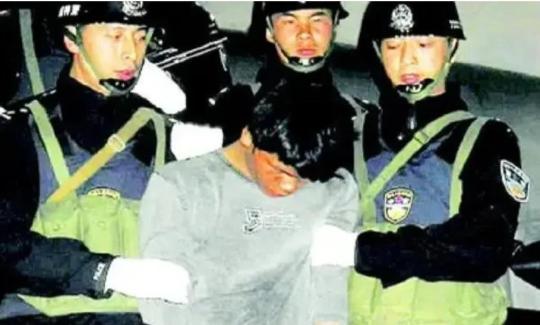
From the 13th to the 15th of February 2004, 23 year-old Jiajue Ma bludgeoned four classmates with a hammer in his dormitory at Yunnan University.
One of his victims, Ruijie Shao, was a roommate of his. His other victims (Kaihong Yang, Bo Gong and Xueli Tang) resided in neighbouring dormitories.
As Ma would later confess, the killings were sparked by an altercation over a game of cards. His friend, Ruijie Shao, had accused him of cheating which eventually escalated into an argument where Shao described Ma as a bad person and made remarks about his poor family. Ma came from an impoverished rural family in a remote village in the Guangxi Region. His family's poverty was something that he had worked hard to overcome by performing extremely well academically and subsequently attending Yunnan University to study Biochemistry.
Ma claimed that he had faced consistent harassment surrounding his background from not only his friends, but several other classmates during his time at the university. It is likely that this was a sensitive subject for him.
During the argument Shao also implied that Bo Gong had not invited Ma to his birthday party due to his abrasive character. Ma was enraged by this disrespect and made plans to kill both Gong and Shao. He researched other murders on the internet then bought a hammer, tape and plastic bags as apparatus for his own murders. He also obtained a fake ID so that he would be able to go into hiding afterwards.
Ma told police that the only reason he had killed Yang and Tang was because they got in the way of his plans to attack Shao and Gong.

(left to right) Xueli Tang, Ruijie Shao, Kaihong Yang, Bo Gong
On the 13th, Ma was alone in his dormitory as Ruijie Shao had gone to stay with a friend. At some point, Xueli Tang came to the apartment and intended to stay the night. Once he was asleep, Ma struck him in the head with a hammer and killed him. He then wrapped his body in a black bag and hid it in a closet.
When Shao returned on the 14th, Ma struck him across the back of the head with the hammer and killed him. Ma also wrapped his body in a bag and stored it in a separate closet.
On the 15th, Kaihong Yang heard that Ma had returned to the university and came to the dormitory to play cards with him. Scared that Yang would discover the bodies, Ma killed him in a similar fashion, putting his body in a bag and hiding it behind a cabinet. Later in the day Ma invited Bo Gong to the apartment to play cards, to which Gong received the same fate as Yang. Gong's body was hidden behind another cabinet.
Over all three days Ma attended class as usual.
After the fourth murder, Ma boarded a train at Kunming station where he used his fake ID to travel anonymously.

The dormitory where the murders occurred
Throughout his life, Ma had been isolated from his peers and struggled to make friends. One of his primary school teachers, Zangyuan Ma, stated that he 'had few friends to play with' as a child. At home he also exhibited problematic behaviour. While speaking about his parents' arguments in his diary he wrote
"I am so angry that I really want to kill him with a knife. My only hope is that my father will die soon"
He later wrote that killing his father would not be worthwhile as he was 15 and so would not get out of prison until he was at least 25.
In November of 1999, at age 18, he ran away from school because he was afraid he would fail the Gaokao exam due to his slipping grades. He was found more than 50 kilometres away from the school by police after a few days.
At University he had not participated in any group events over the four years he had attended and frequently quarrelled with classmates. One student said the following when asked about him.
"All of us felt his mental problems because he always picked fault with others while never thinking he may have done wrong"
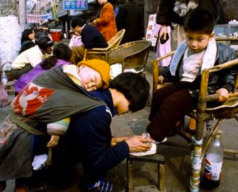
Jiajue Ma as a child
The victims' bodies were discovered on the 23rd of February after another student had complained of the smell coming from the dormitory. After police inspection, Ma was considered a prime suspect and an estimated 1.7 million police officers were deployed on a nationwide manhunt. Additionally, a 200,000 yuan (US$24,000) reward was set for information leading to his capture. The case was closely documented by news outlets and quickly became known nationwide due to the brutality of what had happened to the students. The following is an extract from an article published on the 12th of March 2004, three days before Ma's arrest.
"Producing Ma Jiajue posters has become something like a folk art, as new variations appear every day. The stock of images is limited, but this has not stopped people from rearranging and resizing them, posting multiple photocopies on lampposts, storefronts, and residential entry gates. The repetition looks like an Andy Warhol exhibition. Right now, Ma Jiajue is the best known man in Yunnan. If the Rolling Stones and the reunited Beatles were coming to town, complete with a revived John Lennon and George Harrison, the publicity could not be greater. I don't think the Second Coming would get this much attention."
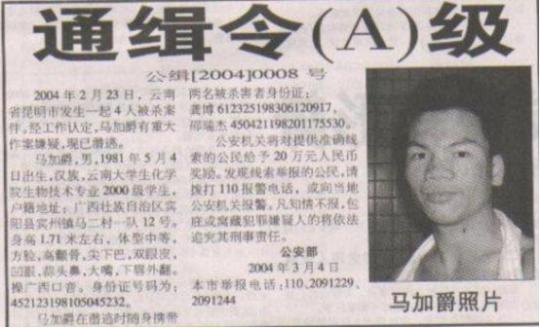
A reward posting in a newspaper
After 21 days at large, on the 15th of March, Ma was apprehended in Sanya, Hainan Province. He confessed to all four of the murders immediately. In custody he showed little remorse. The following is an extract from a letter he sent to family during this time.
"I am sure that this matter has caused some very bad consequences for the whole family. But I can no longer say that I am sorry. When you receive this letter, please forward my wishes to my parents --- you should ask my parents not to mind my business anymore. I don't want to see them again. I am no longer the person that I used to be. As far as my parents are concerned, I know that no matter how tall or how big I've grown, they will always think of me as little number '12'. But I have changed a lot, and when a person goes bad, there is no hope."
Ma was sentenced to death by the provincial high court of Kunming city and his date of execution set for the 24th of April 2004. He did not appeal his sentence. Prior to the verdict, Ma's sister requested the media that he undergo a second psychological assessment but this was dismissed as earlier examinations had shown he was not mentally ill. He was executed by shooting on the 17th of June 2004.
For the sake of consistency all names mentioned have been placed in the western format (forename first, surname last).
91 notes
·
View notes
Text
What is Pain? : How Austin Eubanks Dealt with Addiction and the Aftermath of Columbine.
Austin and Corey
Stephen Austin Eubanks was a junior and a star student in Columbine High School. Corey Tyler DePooter, his best friend, was also a particularly gifted student who prioritized his studies over anything else. Despite having a wide range of interests, the two kids particularly bonded over their shared passion for fishing.
At the age of 17, Corey had gotten a job doing maintenance at a golf club in order to earn money for a fishing boat that he planned to buy with a friend — likely Austin. The two often used to go fishing together and would talk about the struggles they had as teenagers.
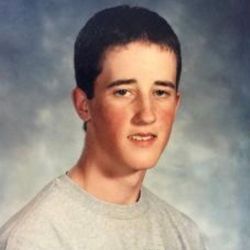
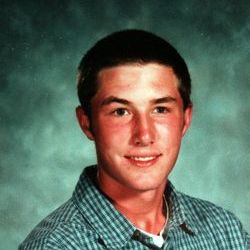
Day of the Tragedy
On April 20th of 1999, the two were inside the library getting ready to get lunch with their friends, Jennifer Doyle and Peter Ball. That was until they had heard shots fired from the outside, not recognizing the sounds and believing that it was only the sounds of construction. Then they heard a bomb go off, a teacher rushing in to scream for the students to hide underneath the table because two students were armed with guns.
In a state of shock and fear, the four duck under the same table near the windows. With 10 minutes passing, the shooters had already entered the library and methodically fired under each table as recalled by him. His best friend, Corey, was one of those who were shot after being aimed with a semi-automatic rifle and shot at the neck, chest, and left arm by Dylan Klebold.
The bullet that hit Austin's hand first passed through his best friend, killing him instantly. With his best friend lying lifelessly beside him and being wounded on his hand and knee, Austin had no other choice than to try to play dead while laying in a pool of blood. When the shooting had stopped, Austin ran through the smoke and out of the backdoor of the library. He was only 17 when the shooting occured.
In Austin's TedTalk “What Columbine Shooting taught me about pain and addiction”, he recalls:
"I remember how I felt: I was confused, I was afraid, I felt sick and I was vulnerable. And just minutes later, I was playing dead underneath a table next to a pool of blood. I had just been shot and I witnessed my best friend murdered right in front of me as we were huddled together waiting for help to come."
Pain, Grief, and Narcotics
During the time he fled from the crime scene, Austin marked that as one of the most impacting and damaging experiences he has ever experienced in regards to the feeling of pain. His definition of pain was nothing similar to what he describes in his present days.
Pain, in a medical sense, is the variably unpleasant sensation of physiological systems mediated by specific nerve fibers of the brain that are conscious of receiving signals of awareness. According to Austin's TedTalk, the American Pain Society introduced the term "pain is the fifth vital sign" in 1996. This means that when you enter the room, your status is assessed using five different data points: blood pressure, pulse rate, temperature, respiration rate, and pain.
Due to a movement that was certain that we were undertreating pain, patient satisfaction surveys were implemented in order to monitor the campaign's success. To him, in order to uphold this new momentum and cause the patient's pain levels to cease completely, the ethical dilemma instantly arose:
“Do I issue this person with narcotics to make them happy or deny them and potentially hurt my compensation, the revenue of the hospital? Or at worse, open myself up for a grievance for undertreating pain that could potentially result in the loss of my job?”
Austin says that the healthcare system predominantly treats physiological systems and would rather not assess emotional pain into the equation. He akins the emotional pain of dealing with trauma being identical or if not more than when dealing with physical pain. With that, within months after the incident, Austin was prescribed opiate medication for his injuries.
In an exclusive interview with The Fix, he said that his injuries were not to the point of needing an opiate pain medication but was immediately given a 30-day supply and became addicted within three months. From then on, he said, “I used substances every day, day in and day out.”
After the shooting, his parents took him to a therapist who said Austin was too shut down to process his horrific trauma. But the reason no one could reach him was because he was overmedicated. He was addicted to painkillers, and used medication because of his unwillingness to engage in the stages of grief that he dreaded to face. He was haunted by the past. Struggling with survivor's guilt and the death of his best friend, he would rather ignore the intense burdening feelings he bore. According to him,
“Acute Physical Pain ends relatively quickly, complex emotional pain does not.”
The morphine Eubanks received at the hospital that day proved to be the opening dose of a costly addiction to prescription painkillers - one that revolved around commonly prescribed drug Oxycontin, he said.
“I learned to manipulate doctors … I could literally get whatever I wanted. Telling them I’d been shot at Columbine and lost my best friend was like [getting] an open prescription book from any doctor.”
He could not process the grief, moreso, he didn't want to. He didn't want to be haunted by the memories that scarred him. In his own words, he would describe the physical ailments he felt to be a 4 or 5, but the emotional turmoil was a 10.
Austin never set foot back to Columbine. His parents hired a tutor and he then went on to graduate in 2000. He attended the Columbine ceremonies but never went back inside the school. He then went into advertising and married in his early 20s. Around this time his substance abuse escalated, and his first attempt to get sober was in 2006. He went into a 30-day inpatient program but failed within hours of leaving, for relapsing using pain pills and Adderall.
Addiction and Sobriety
He failed both outpatient and rehab twice and it wasn't until 10 years later, in 2009 that he was able to overcome this addiction. Right before Columbine, young Austin had been misdiagnosed with ADD.
“I didn’t have ADD,” said Eubanks. “I just liked being outdoors and playing golf better than being in school. At that time, if anybody was truant at school they said, ‘Oh, they must be ADD. Let’s put them on a stimulant.’ That was why I got Adderall. I liked it because I could abuse opiate pain medication to the level that most people would be nodding out. With Adderall, I could function. Basically, I was doing oral speedballs. It was like using methamphetamine and heroin.”
His second try at being sober was in 2008. Gaining the motivation to change after recently separating from his wife, he went to treatment, stayed 90 days, and achieved eight months of sobriety. Then, he akinned addiction to a causal sequence, a domino effect. According to him, he achieved abstinence for a period of time, built up enough false confidence to where he thought he could drink, because alcohol was never a problem. From alcohol, he went to weed, then Xanax, then Oxycontin, and then back into the same routine.
In 2011, approaching the age of 30 and estranged from his wife and kids, he hit rock bottom: "My sobriety date is April 2, 2011. I woke up in a jail cell and had no clue how I got there." His downward spiral began with Oxycontin and alcohol abuse, leading to arrests for various offenses like car theft and fraud. Realizing that he needed a drastic change, he recounted that his lowest moment was waking up in withdrawal, hungover, and facing the ruins of his marriage and being estranged from his children. He knew he had to stop or he would die. After unsuccessful attempts at sobriety, he finally sought help, surrendered to treatment, and was now willing to follow any guidance to rebuild his life.
His journey to lasting sobriety didn't hinge on traditional 12-step programs, but rather on understanding behavioral triggers and brain function through a therapeutic community approach. He was five years sober and started working at The Foundry in Colorado, becoming the COO and handling approaches that combined neuroscience with 12-step principles, recognizing that each person's path to recovery is unique. Using comprehensive approaches aiming to rebuild the lives of those in recovery.
During this time, he would also indulge in old activities in remembrance of his bestfriend.
“It’s something I do to connect with Corey. It's always nice whenever I catch a fish that's above the normal or something special about it. I always tend to look up and give a nod to him. And I know he’s still looking out for me."
Sadly, despite his long battle against drug addiction, in 2019, Austin had passed away in his home in Colorado after an accidental heroin overdose. Just a month after the 20th anniversary of Columbine, Austin was 37 at the time.
What is Pain?
Pain, to Austin, encompassed many things: the confusion and vulnerability of not knowing what to do in such a time of terror, the physical wounds that the doctors tried to medicate to bring the pain meter to zero, and most importantly, the emotional hurt of knowing your best friend was gone, taken right in front of you. Knowing that very moment can never be undone.
His advice for survivors dealing with the same guilt is to feel it. Don't run away from it. Survivors often find other things that allow them to detach from the pain, but to him, that's the wrong choice.
“You can heal physical pain while you’re medicating it. You cannot heal emotional pain while you are medicating it, In order to heal emotional pain, you have to feel it ... You want to feel better immediately, [but] you have to have the courage to sit in and feel it, and if you can do that long enough, you will come out on the other side.”
Along with post-traumatic stress, there is also the potential for post-traumatic growth.
“That doesn’t imply you will ever be the same person again. After a trauma, you will be changed forever.”
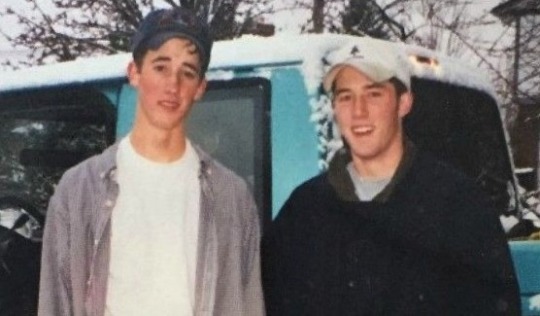
138 notes
·
View notes
Text
SPOILERS„InsideOut 2”
Personal opinion, experiences *
* The author is not an expert in criticism and presentation of thoughts.
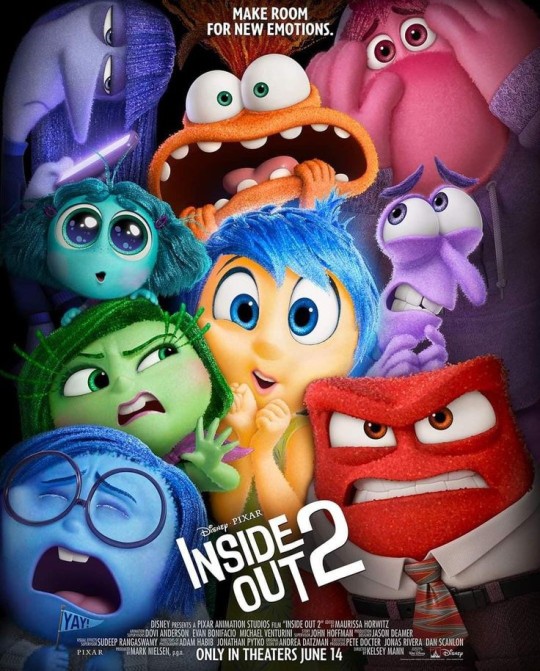
I watched the „Inside Out 2”, And I cried at the end.
The way anxiety takes control, overriding other emotions for Riley's benefit... Creating new beliefs and memories that lead to nothing good.
It's all done so realistically, when Riley had a panic attack I started crying, I feel like the same thing is happening to me. Only that very moment when all the emotions come together, when joy saves Riley, never came...
I don't want to do anything, I don't want to know anything, I can't do anything... If only a happy ending would come for me when this condition lets me go.

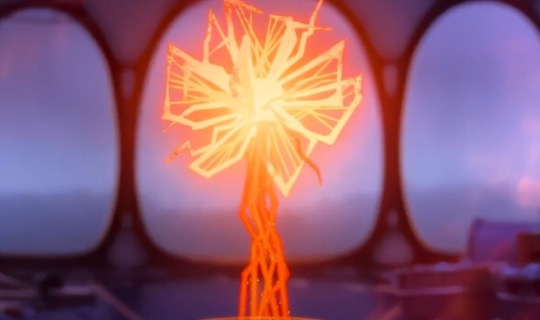

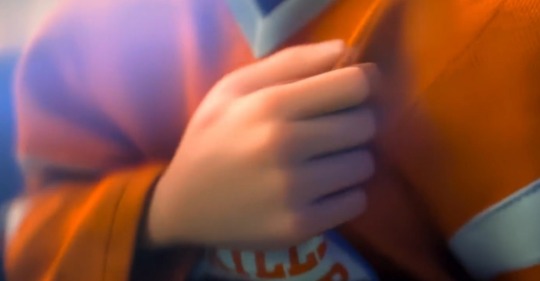

As a person who experiences similar things, I can say with certainty that everything is shown PERFECTLY!
How joy takes “unnecessary” memories and sends them into the abyss...(Only in my case I forget both the bad and the good).
How anxiety plans future possible outcomes and you can't sleep.
The end is ideal, as anxiety would “freeze” at the control panel and cannot be removed... as even if you move it away, the state after it simply does not go away.
I like it Inside Out2 Just like the first part, I was afraid that the continuation might ruin everything, Yes, it seems to me that even more moments could have been added and the storage space was not enough for such a large idea..
I can’t imagine what will happen in part 3 if there is one, but I think it will turn out just as great as in the first and second cartoon!

I do not express my opinion as an expert 😅😅
But I think those who have already watched the cartoon will understand what I mean.
20 notes
·
View notes
Text
ayo! i think i need an info post, bc theres some questions im tired to answer
im ivvmell/iva
comms closed
open to all kind projects: collabs/zines/requests/etc
ru/eng 🇷🇺🇦🇲, 18+, no dni, any pronounces
repost, using, etc only with credits
telegram//bluesky
19 notes
·
View notes
Note
THAT WAS THE PROLOG?! Holy shit what's the main story gonna be like then???
Hot damn. Anyways, will you be taking a break b4 continuing, or just continue with the main story line? :0 both are perfectly fine of course, no pressure :)
i've been sitting on these plans for 2 YEARS. YOU HAVE NO IDEA
and as for when we will be continuing, january is going to be my little fun month where i do whatever i want, so i'm expecting to continue this in february or march! i have a lot more gijinkas i need to either refine or create from scratch and a little bit of environmental design before we can get into chapter 1
20 notes
·
View notes
Text

༊*·˚ european. university student. chronic procrastinator.

secondary blog. main @konigbabe-interact (I interact and follow from there). multifandom (18+).
I do not allow to copy/modify my work or take inspiration from my work in a form of using the same story ideas I come up with.

REQUESTS ARE CLOSED // thirsts and drabbles requests opened but feel free to share your ideas with me, maybe I’ll get inspired

࿐ྂ LINKS:
masterlist ┊ao3┊navigation┊writing list┊faq┊ko-fi

࿐ྂ RECENT
✎ eleusinian mysteries (Satoru Gojo x fem!reader x Toji Fushiguro x Kento Nanami x Choso Kamo gangbang) – NSFW week ✎ pearls before swine (kitsune!Satoru Gojo x fem!reader smutty oneshot) – NSFW week ✎ frosting of my cake (Satoru Gojo x fem!reader smutty oneshot) – NSFW week

࿐ྂ TRENDING
✎ feast of pleasure (Ghost x König x Keegan x fem!reader foursome smutty oneshot) ✎ perish (Satoru Gojo x fem!reader angsty oneshot) ✎ the taste of scotch (John Price x fem!reader smutty oneshot)

CREDITS: dividers are mine; account header by @acotars [source]; account icon is called "Milky Way" by Maksim Viktorov on deviantart [source]
72 notes
·
View notes
Text

the new shooters instagram
106 notes
·
View notes
Text
By the way...
The official system requirements for inZOI if you're curious:
Minimum System Requirements for inZOI To simply get started with inZOI, your computer will need to meet the following hardware criteria: CPU: Equipped with at least an AMD Ryzen 5 2600X or an Intel Core i7-6800K, your processor should be able to handle the basic demands of the game. RAM: 16 GB is required for your system to run inZOI efficiently, letting you enjoy gameplay without significant lag. Video Card: A GPU such as the AMD Radeon RX 5600 XT or NVIDIA GeForce 1080 will be necessary to render the stunning graphics inZOI offers. Dedicated Video RAM: 6144 MB is the minimum to ensure those graphically intense moments look as beautiful as intended. Pixel Shader: Version 5.0 support is needed to achieve the full visual effect of various in-game textures and lighting. Vertex Shader: As with pixel shader, version 5.0 is required for proper rendering of the game’s complex models and environments. OS: Ensure that you have Windows 10/11 with the latest updates installed to support the game's software requirements. Free Disk Space: A minimum of 50 GB of available disk space will be required to install and run the game comfortably. Recommended System Requirements for inZOI For those wanting to experience inZOI in all its glory with high frame rates and the most detailed visuals, aim for the following recommended specifications: CPU: A more powerful processor like the AMD Ryzen 5 3600X or the Intel Core i5-10600K will deliver a smoother performance even in the most demanding scenarios. RAM: Doubling the minimum requirement, 32 GB of RAM will ensure that your game runs seamlessly and enables extensive multitasking. Video Card: Upgrading to an AMD Radeon RX 6800 or NVIDIA GeForce RTX 3080 video card will allow you to enjoy inZOI at higher resolutions and with better graphical fidelity. Dedicated Video RAM: A hefty 10240 MB will give you the bandwidth needed for ultra-quality textures and prevent any graphical stuttering. Pixel Shader and Vertex Shader: Remaining at version 5.0, but coupled with more robust hardware, you’ll be able to maximize the game’s visual settings. OS: Windows 10/11 with the latest updates is again recommended for the best compatibility. Free Disk Space: A consistent 50 GB of free space is recommended for game files, mods, and updates.
6 notes
·
View notes
Text
My Ao3 Page
Things to Know About Me and My Writing:
21 years old; Irish; Autistic; They/she; Mainly write longfic with heavy usage of OCs, obscure lore, and neglected canon characters I believe deserved better. My software of choice is Scrivener and Dropbox.
Mainly write about which of my current special interests I'm hyperfixating on, so my workflow isn't as consistent as other writers. I write when my brain allows, and sometimes that means 5 updates a month, and sometimes it means 1 update a year. The trade-off is that by doing it this way, each update has actual effort/quality as opposed to forcing myself to adhere to a schedule to the story's deficit.
My main special interests I cycle through are Twisted Wonderland, FFXIV, Elden Ring, and of course DC Comics (particularly Captain Marvel/Shazam!). The majority of these fandoms are extremely lore dense, which is reflected in my style of writing, which favours longfics, so expect my work to be wordy.
My fics tend to be on the more canon-compliant side, I like to write what I wished to see in the original, for example. For now, my work is plot heavy, with most relationships being platonic in nature. However, I may explore romance in the future.
3 notes
·
View notes
Text
The Pinnacle of Self-Hatred: A Close-Reading on Elliot Rodger's Manifesto
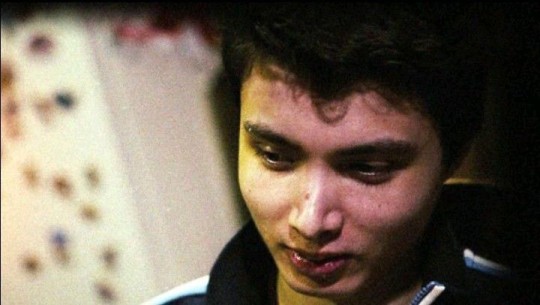
“I named it the Day of Retribution. It would be a day in which I exact my ultimate retribution and revenge on all of the hedonistic scum who enjoyed lives of pleasure that they don’t deserve. If I can’t have it, I will destroy it. I will destroy all women because I can never have them. I will make them all suffer for rejecting me… And I will slaughter them like the animals they are.” (Rodger, 2014, p. 101)
On the Friday evening of May. 23, 2014, Elliot Rodger had perpetrated the Isla Vista Killings. A series of stabbings and shootings that claimed the lives of six people, injured fourteen, and concluded with his own death from a fatal self-inflicted gunshot wound on the head. Before this, Elliot was like any other normal teenager growing up.
As he mentioned in his own manifesto, he had a seemingly good childhood up until his parent’s divorce. Even until the separation, he still spent time with both sides of his family, maintaining the privilege to have access to many luxurious items such as a collection of designer clothes and even a BMW 328i. He traveled a lot, and at just the age of one, he had already traveled to France, Sussex, Malaysia (where his mother grew up), Spain, Greece, and California.
People on platforms such as Reddit often questioned why no one considered dating him at all. Elliot had also asked himself this question time and time again. In one of his youtube videos, entitled, “Why do girls hate me so much” he says:
“I’ve been attending college in Santa Barbara for two and a half years now, in those two and a half years I have experienced nothing but loneliness and misery, and my problem is girls. There are so many beautiful girls here, but none of them give me a chance and I don’t know why. I don’t know why you girls are so repulsed by me.”
While it is easy to dismiss that Elliot solely acted upon his crime because he thought that girls were the problem, upon the surface where misogyny lies, there are layers upon layers of complexities that shaped his views. Elliot did not simply hate women and men who got with women he dreamed of, it was that ultimately, he hated himself—a hatred that manifested toward outward factors.
Elliot has exhibited a long string of stunted self-worth ever since he was a child, and while it is easy to throw around names like: monster and pure-evil; the fact remains: he is still considered a human amongst all those. One who is consumed by insecurity.
In understanding a crime, we must first examine the criminal and approach their case with empathy. Understanding the human aspect of these criminals does not however mean that one should excuse, dismiss, or condone their actions. Only understand the reasons behind their motivations. Here are some aspects I have noticed in his personality and life that may be able to better explain why.
MATERIALISM AND INSECURITY
In his manifesto entitled: “My Twisted World”, Elliot had confessed to having lived a good childhood. He was a nice kid who lived a nice life, up until his parent’s rocky divorce. While reading his manifesto, I have garnered his tendency to place his worth on materialistic things, moreso, his wealth. There were two instances of this on pages thirty to thirty-one of his manifesto. The first was when he was hesitant to invite his new friend from school over to his house because he was ashamed of his wealth:
“I was a bit hesitant to invite anyone from Pinecrest to my mother’s house, because it was located in Canoga Park, a bad area, and most of the kids at Pinecrest were upper-middle class who would look down on me for living there.”
On page thirty one of his manifesto, Elliot said that he was eager to receive an Xbox solely because many kids from his school wanted it:
“My mother bought me a brand new video game console, the Xbox. I heard a lot of kids talking about how great the Xbox was at school, so I was really eager to have one.”
This trait had continued on to his older years. In the same video where he questioned why girls disliked him so much, he stated:
“I do everything I can to appear attractive to you. I dress nice. I am sophisticated and magnificent. I have a nice car, a BMW.”
From this, it’s observable that Elliot tends to desire things just because other kids desire it too. This is rooted in his craving of validation and acceptance. This materialistic need for validation also transcended from mere objects to even his own appearance. Whenever he did not have what others had or wanted, he would be very ashamed of himself.
At the age of six, Elliot had moved to Topanga Elementary Charter School, a school based in California. The school has a thirty two per-cent minority rate, making seventy eight per-cent of the ethnicity population white. With the population being predominantly white, Elliot had developed a view on the world that separates people by their differences: the “cool kids” and the “losers”. Mostly, Elliot described these cool kids as the higher-class, privileged, centered on attention, and white.
“I realized, with some horror, that I wasn’t “cool” at all. I had a dorky hairstyle, I wore plain and uncool clothing, and I was shy and unpopular. I was always described as the shy boy in the past, but I never really thought my shyness would affect me in a negative way, until this point. This revelation about the world, and about myself, really decreased my self-esteem. On top of this was the feeling that I was different because I am of mixed race. I am half White, half Asian, and this made me different from the normal fully-white kids that I was trying to fit in with.”
He even dyed his hair blonde and tried to pick up on skateboarding because he thought it would make him appear more cool. On his manifesto he wrote:
“My first act was to ask my parents to allow me to bleach my hair blonde. I always envied and admired blonde-haired people, they always seemed so much more beautiful.” (Rodger, 2014, p. 17)
“I then started to notice that all of the cool kids were interested in skateboarding. I had never even ridden on a skateboard before, but if I wanted to be cool, I had to become a skateboarder.” (Rodger, 2014, p. 18)
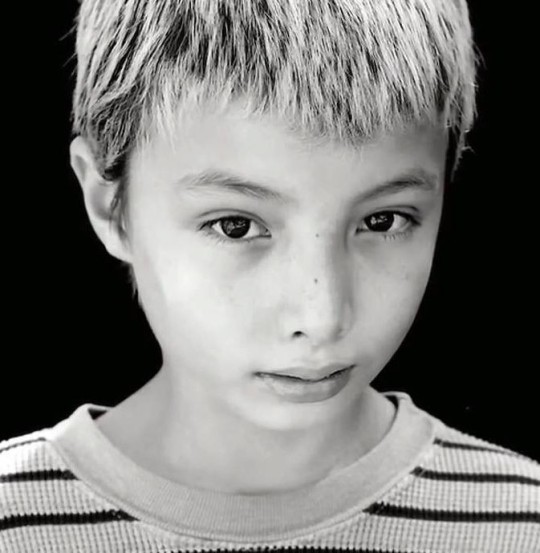

This materialism had soon influenced his fixation on racial hierarchy. Elliot in his older years constantly demeaned and berated others of asian descent even if he was half-malaysian himself. To him, he considered whiteness as a prestige. On platforms such as reddit and facebook, he had made several negative comments regarding the appearance of some Asian men.
A comment he had left on a reddit thread stated:
“Full Asian men are disgustingly ugly and white girls would never go for you. You’re just butthurt that you were born an asian piece of shit, so you lash out by linking these fake pictures. You even admit that you wish you were half white. You’ll never be half-white and you’ll never fulfill your dream of marrying a white woman. I suggest you jump off a bridge.”
The paragraph entails Elliot calling out a man for linking fake pictures of himself. Elliot speculates that the man had done this because he wished he was white, then he tells him how he was not considered as attractive because he was simply born Asian. Elliot was also very fixated on his looks, specifically his height. He had repeatedly mentioned his envy of other boys and even girls who were taller than him.
On page fifteen of his manifesto, he wrote:
“As Fourth Grade started, it fully dawned on me that I was the shortest kid in my class – even the girls were taller than me. In the past, I rarely gave a thought to it, but at this stage I became extremely annoyed at how everyone was taller than me, and how the tallest boys were automatically respected more. It instilled the first feelings of inferiority in me, and such feelings would only grow more volatile with time.”
In other instances, he also noted that he was bullied for being physically weak and short, and often he would blame this solely on his descent. He saw being mixed as a form of inferiority because this made him “undesirable”. His image of attractiveness is measured by euro-centric features: fair-skinned, blonde, blue eyes, and tall. In many instances, he changed parts of himself to better fit the narrative of being “cool”.
To him, it’s all a part of growing up and fitting in, but what he failed to see is that the more he takes and changes parts of himself for people to like him, the more it just makes him hollow. Elliot’s childhood and teen years, best summed up, is a fixation on trying to keep up with those who are higher on the social status ladder and this continued to his later years.
EARLY EXPOSURE TO PORNOGRAPHY AND SEXIST MEDIA
Elliot was lonelier during his teen years, at 13 years old, he stopped having contact with his only friends because they started having their own separate lives together, making him spend more time alone by himself (Rodger, 2014, p. 38). This was when Elliot recounted his first-time exposure to pornography by catching a teenager watch it in an arcade called Planet Cyber. He re-called it as a traumatizing experience, confused on why such an explicit thing would be considered as “love”. Despite this, his innocence was damaged by this accidental exposure. Though he did feel aroused, he was more guilty and confused.
“One time while I was alone at Planet Cyber, I saw an older teenager watching pornography. I saw in detail a video of a man having sex with a hot girl … I didn’t know anything about sex at the time. I barely even knew what sex was. I was slowly starting to develop sexual feelings for hot girls, but I didn’t know what to do with them. To see this video really traumatized me. I had no idea what I was seeing… I couldn’t imagine human beings doing such things with each other. The sight was shocking, traumatizing, and arousing. All of these feelings mixed together took a great toll on me. I walked home and cried by myself for a bit.” (Rodger, 2014, p. 38-39)
This was the pinnacle of Elliot’s misery. A kid who searched for validation with his looks, now searched for it in sexual gratification as well. He only found himself loved if people flocked over to him. Furthermore, he had this distorted mindset that his worth is only measured by how many girls he could get and how fast he'd lose his virginity. This can be akin to the stereotypical portrayals of boys in media that often influenced teens and their concept of self-worth: the "cool" guys having lots of girls, while nerds and "losers" have none.
With this type of thinking, he tried his best to gain things that he thought women would like, yet he did little to no effort to actually get to know them and socialize. He believed that just because he had what others wanted or did not, people would love him. According to his friends, they thought he was almost always one-sided, expecting women to just swoon over him because he has things that are desirable.
ENTITLEMENT
Furthermore, despite his initial pleasant middle school years at Pinecrest High, such as dancing with a girl during a school dance (Rodger, 2014, p. 29), socializing eventually became difficult for Elliot. Often, this is because of his appearance, where he experienced bullying because of his height. According to his friends, he barely talked to women but still complained no woman wanted to talk to him.
Elliot was easily persuaded and subjected to peer-pressure because he had no clear identity. He always followed what was the trend because it made him feel less insecure about himself, since it was what he thought the people accepted and desired.
Despite his insecurities, Elliot had a fine record for being privileged, which he used to his advantage to "fix" certain qualities in himself that he deemed undesirable. Ever since he was younger, he often used his wealth to modify certain aspects of himself, even the smallest things: dyeing his hair blonde, purchasing designer clothes to appear more attractive and rich, purchasing mass amounts of body-building pills, and only picking up hobbies such as skateboarding and basketball solely because he found them useful in climbing up the social ladder.
Elliot also had a strong dislike for people who did not support his motivations. He expressed a strong resentment toward is step-mother, Soumaya, because of her assertive nature. He considered his dad to be “weak” for following her orders around, when in truth, she was only trying to teach Elliot a lesson about independence.
“Not only did she kick me out of father’s house, but she forbade me to go there even for a short visit. And still, father didn’t do anything about it. Father kept saying that the house is her house as much as his, and that she has the right to kick me out. No! I am the eldest son! The house should be MY house before hers! This caused any respect I still had for my father to fade away completely. It was such a betrayal, to put his second wife before his eldest son. What kind of father would do that? The bitch must be really good to him in bed, I figured. What a weak man.” (Rodger, 2014, p. 62)
At his step-mother’s insistence, Elliot began looking for a job and eventually found work from a family friend who offered him a job for a house construction project. He felt more comfortable with it, seeing the job as helping rather than typical employment. After getting his driver’s license, Elliot enrolled in summer classes at Moorpark College but struggled with attendance, again, due to his jealousy of campus couples.
He dropped out midway through, briefly worked as a janitor at an airport office, and quit after one day. Knowing his mother would be upset, he re-enrolled at Moorpark but eventually dropped out again (Rodger, 2014, p. 70). Upon learning of Elliot’s decision to drop out again, his parents decided he would move to Santa Barbara, where he would live alone in an apartment paid for by his mother, receive a $500 monthly allowance from his father, and enroll in classes at Santa Barbara Community College (Rodger, 2014, p. 77).
CONCLUSION
Elliot is very persistent on the idea that to be accepted, he needed to be loved, when in truth, he couldn't bear to accept himself. No one has absolutely any obligation to love someone because the other sees it as a form of validation. Self-worth comes from yourself, not from others. Due to Elliot’s constant fixation on trying to be accepted, he lost the identity that made him authentic and genuine. He lost what other people could not give him: self-worth.
Concluding, Elliot Rodger is a complex individual that cannot be summed up to one set character. He is not solely “pure evil”, he is a person with a background that influenced his decisions. He is not less deserving of humanity or empathy because just like others, he had also felt humane emotions. With criminals, it is always important to remember that to understand a certain event or phenomena of crime, we also have to understand not just the perpetrator that the media portrays, which is often easily pushed into a oversimplified narrative of “pure evil”; we must also consider the genuine person behind the crime.
While it is important to recognize that these are profoundly disturbed individuals who must be held accountable for their actions, it is also crucial to understand that despite their crimes, they still remain human. Although, this does not mean that his background excuses or condones his actions. It only provides a framework to comprehensively understand both the case and the criminal behind it.
#elliot rodger#isla vista 2014#understandnotcondone#infopost#analysis#updated version of my first elliot analysis. yay!
80 notes
·
View notes
Text





//ooc under cut
howdy! ketsukanekid mod here!!!
this blog is related to @/passingthroughthenorthstar's AU! kanako is roughly ~14-16 years old, and is on decent terms with her mother she still tends to spend time with her other friends and effectively-adopted-family though. usual no-no list applies. tags: kanako answers - self explanatory kanako chain - self explanatory ooc - self explanatory mod responds - self explanatory infopost - self explanatory
#underblog💛#kanako answers#kanako chain#ooc#mod responds#infopost#intro post#intropost#askblog#ask blog#undertale yellow#uty#kanako ketsukane
12 notes
·
View notes
Text
Happy birthday to me!

Today is my birthday.
Just recently there were still 101 of us But now, my dear readers are already 158!
This is a great achievement for me!
Thanks to everyone who joined and follows my work!
✦SUPPORT ME✦
#happy birthday#30th of March#30March#artist#birthday#artist on tumblr#digital artist#Desi_info#Info#InfoPost#artists on tumblr
15 notes
·
View notes
Text
Okay folks, time for someone who has been in fandom for decades to give some history and vocabulary, because I woke up thinking about a post that tells me you all do not actually know it!
We'll start off with some simple history! First, disclaimers on fanfiction used to be vital because creators of source material could and would sue fanwriters and artists for using their work. We have largely gotten protections from this because AO3 does not allow monetization. They cannot protect you if you try to make money off your fanfiction. Fanartists, I know you have it harder, and I wish you luck, as you have more leeway, though not as much as many presume. Suffice to say, disclaimers were vital, and should be respected for the history they represent instead of being mocked.
Next up! Tagging! Tagging is a courtesy that you, as a creator, do for your fans. To not tag is a choice, and it means that your readers are taking the risk that they might see something they do not like. If you are choosing not to use tags, and there is dark content in your story, properly use the 'author chose not to use warnings' tag on AO3, or, if you are elsewhere, simply give a blanket warning for dark themes as I'm aware there is no rating system on a site like this one you can use for the same. Readers, if you see these tags, do not get angry at the author for seeing something you didn't want to see! These tags don't mean that the fic had nothing to warn for, it means the goal was to keep plot points a surprise!
Vocabulary Old and New.
Squick This was the word that inspired this post. The historical origin of this word comes from a fetish which is, as one might expect, kind of horrifying and, well, squicky. Initially used to describe the kink of, brace yourselves, eyefucking, it made its way into common usage in fandom to indicate anything that made a reader uncomfortable, regardless of how benign it might be. People can have a pregnancy squick. People might be squicked by reading about hand holding and cheek kisses between characters who are underage. People might find gory battle descriptions squicky. Or, alternatively, someone might not really be squicked by anything, and can consume any media without concern. You do not know, and there is no judgement implied in the word squick. There is no such thing as something that is squick-free.
Squick means 'I don't like this and wish to not engage' and that is considered more than acceptable. No one has to interact with things that make them uncomfortable in fandom.
---
Cringe The new kid on the block, a term that people presume means the same thing as squick, and thus new kiddies who haven't seen or heard the term squick might be irritated about. They are right and they are wrong. Cringe, as one might be aware, is in fact what someone does when they are squicked by something. Physically. However, cringe in modern culture has connotations. People in the modern day use cringe to indicate judgement.
When someone is being cringe, the person making that call is saying the other person is doing something that, socially, is embarrassing to them and that they shouldn't be. They are indicating that that other person should cease because it makes them uncomfortable.
Cringe means 'You are doing something I don't like and you should stop because I don't like it'. This is not up to you. Other people get to live their fandom lives without judgement. I advise if you find yourself thinking 'cringe' at something, you should navigate away instead of interacting or expecting them to stop.
---
Trigger Okay, this one is a very clear line. This is not about something that makes you uncomfortable, regardless of if you are doing a judgement on it or not. This is something that directly reaches in and gives you a visceral reaction which you cannot control. Triggers are physical, unpleasant, and can cause severe reactions in the person who are affected by them.
Triggers are not 'oh, I'm mildly uncomfortable with this content' as sometimes it is used. Triggers are 'oh god, I'm being hit right in the chest and I need to make it stop right now'. There is a difference. Please, everyone. If someone says they're triggered, do not assume that they have a choice or that they should just get over it. It is not a judgement on you or them.
Triggers should be respected as the serious thing they are.
---
Yaoi/ Yuri/ Slash Okay, so these are all words that indicate homosexual+ relationships. Yaoi and Yuri are from Japan, with Yaoi being the old male/male term which was a series of words in Japanese that, sadly, I've largely forgotten the meaning of, but I do know that it ends in 'no resolution'. Because in Japan, especially at that time, homosexual relationships were considered to be the sort that would go nowhere and end in nothing. Yuri, in contrast, is the name of a flower and means Lily.
Slash is the more modern term to indicate a relationship between two or more people of the same gender, and the name came about because of the way pairings have often been written. Name/Name.
---
Lemon/ Lime/ Citrus This used to be the old way of indicating explicit content that would keep authors from getting their work taken off of websites for having explicit content. Sometimes people labeled fics with these even if there was nothing particularly objectionable because they would get targeted by unpleasant folks or get caught up in website sweeps trying to 'clean up' a website.
A Lemon is a very explicit sexy scene. A Lime is a scene with heavy petting and implications of more. Citrus means that something about the scene is intended to be spicy.
---
Math Pairings/ Name Smooshing/ Pairing Titles Math names were a thing that came about because a lot of fandoms earlier on in internet fandom had character names that could be turned into numbers. Gundam Wing was notorious as they had characters numbered 1-15 in different languages, and so you saw a lot of 1x2x5 or 3x4+1xR/D <-both of these are pairing tags I saw on fics. Saiyuki was another fandom with math for pairings, though I cannot think of any off the top of my head as I was never in that one.
Name Smooshing is older than internet fandom. Spirk comes to mind as Spock/Kirk from Star Trek, and that brings us all the way to the modern version of this with Bingqiu and Cumplane from the Scum Villain's Self Saving System or Hashimada from Naruto. If you're in those fandoms, you know who I mean. The most unfortunate version of this I ever saw was back in FFVII before Aerith's name was Aerith and was instead Aeris. The ship was Clotiris. It was a threesome.
Pairing Titles are a thing I've only seen in a couple fandoms, and none I was specifically active in, but, and I know everyone is up in arms because of the author, but fandom history is fandom history. Harry Potter had titles like the Pumpkin Pie ship, among others. I know other fandoms have had them, I've seen them, but they don't stick in my mind the way the other two types of ship usage do.
---
ABO The Alpha Beta Omega phenomenon was started, very initially, by a guy doing a study about wolves. He made a mistake and ended up looking at a family unit with parents and a bunch of kids, which skewed all his data, and the guy has since admitted his mistake. The legacy of said mistake, however, will live in fandom forever.
The ABO trope in fandom is one which involves normal characters in their normal world having some hermaphroditic (or intersex, whichever you prefer to use) tendencies, as well as more predominant animalistic ones. This trope involves people having heats, ruts, heightened senses of smell, the affect of hormones on a person, and both men and women having dicks (or not) while otherwise being as canon painted them, as well as other wild variations.
You must tread carefully when reading ABO! Some ABO fics are cute nesting fics with lots of cuddles and everyone keeps a brain in their head. Some ABO fics are non-con charnel houses where everyone is all instinct all the time. Some ABO is well thought out, and other ABO is not. You will find as vast of an array of ABO as you'll find of any other genre of fic like Hurt/comfort, sci-fi, time travel, or genderflip. It's not a narrow field, and it's got both amazingly innovative interpretations as well as awful ones.
Don't judge all ABO on the works of one author, or you'll probably be unpleasantly surprised. However, if you don't like Mpreg this is almost 100% not for you. That is, in fact, a feature and not a bug.
---
Mpreg Males who are pregnant. Doesn't matter how, but that's what this is. That man is pregnant. That's the fic, that's the tag. Now you know.
---
Genderbend/Genderflip/Genderfuck/Always Another Gender This is actually two categories of story, though the terms are often used interchangeably in tags aside from the last one. The first two are often used to mean the third, however, so watch out just in case!
Basically, the premise of stories with these tags is exploring what a world would be like if a character were another gender, because much as we all might not like it, gender plays a huge role in how people, or in this case characters, are reacted to. That can radically change a story. However, the first three have also been used to indicate a character whose gender is changed in the story. Genderfuck, in my experience, has almost always been used exclusively for an in-story gender change of some kind, though, as these things go, not always.
---
Dead Dove Do Not Eat Originating from a scene in a TV show, where a character took a bag labeled like this and looked inside, hoping for a bagged lunch, and then wondered why they were surprised they got exactly what it said, this term is used in fandom to indicate that the author did their best to warn you, now it's up to you. If you look at that point, it's not like they didn't tell you what was inside, and they have no idea what to do about it now. Often, this term is slapped on fics where there are a lot of warnings, usually after an author has had people get upset at their work for having exactly what their warnings indicate in the past. If you see it, tread carefully.
---
YKINMK(ATO) Your Kink is Not My Kink (And That's Okay!)
This used to be the running anthem of many fandoms and went hand in hand with squick. You could like whatever you liked in your fandom experience, and that was that. You liked what you liked and no one judged you for that. If you liked reading gory horrific angst, or incest slice of life, or just stories about people building puzzles, there was nothing weird about it.
What you like to read and interact with in fandom is not, after all, any indication of what you agree with or approve of people doing in real life. That's just a fact. Fandom is not your hopes and wishes for yourself. Fandom is a fantasy, and you can explore whatever you want in a fantasy. You're allowed to feel safe doing so.
Do not judge others just because something squicks you. That was what this meant, and means even now. It's fine if your friend likes something you don't, they're still your friend. That's okay, and that's fandom.
---
I hope that this post has been helpful, and if any of you have questions about other fandom terms or what they mean, I would be happy to help you understand! Be happy, have fun, and don't let the world get you down. You control your fandom experience, and don't let anyone else tell you different!
4 notes
·
View notes
Text
- Blogregeln -
Für 2024 werden die Blogregeln minimal angepasst, daher hier die wenigen Regeln, die ich gerne nochmal erläutern würde. • Alter, Geschlecht und Wohnort ist grundsätzlich egal (wer es jedoch angeben möchte, kann das sehr gerne tun, da es als Hashtag unter den Betrag kommt) • Bitte keine Einzeiler einreichen. Diese werden kommentarlos gelöscht - macht euch interessant! • Gebt euch ein bisschen Mühe bei eurer Vorstellung. • Keine Dating oder S*xanfragen. Dafür ist die Seite nicht da. • Ebenso werden Blogs mit überwiegendem Porn-Inhalt geblockt. • Solltet ihr von einem Mitglied belästigt werden, MELDET EUCH bitte bei mir. Nur so kann ich diese Menschen von der Seite ausschließen • Seit nett zueinander und vermeidet Ghosting. Sowas ist für niemanden schön. • Wenn euer Beitrag gepostet wird, ist der erste Tag euer eigener Freundescode (z.b. für jetzt: 1801241330, bestehend aus Tag, Monat, Jahr und Uhrzeit). Merkt euch diesen bitte, falls ihr euren Beitrag mal löschen wollte oder andere Anregungen oder Ideen habt. Das wars auch schon. Habt ne schöne Zeit!
14 notes
·
View notes